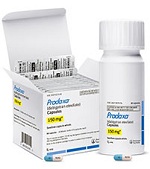 |
Boehringer Ingelheim, determined not to let clot-fighter Pradaxa be outdone by Bayer and Johnson & Johnson's ($JNJ) Xarelto, has added a couple of new uses to the drug's label, snagging the FDA's OK to treat deep vein thrombrosis (DVT) and pulmonary embolism (PE) in some patients. But it still has a long way to go--and some safety concerns to dispel--before it can retake the anticoagulant throne.
Monday, the German company announced that U.S. regulators had green-lighted its therapy to treat DVT and PE in patients who have already been treated with an injectable anticoagulant, and to reduce the recurrence of DVT and PE in previously treated patients. The agency based the expansion on three trials that showed Pradaxa matched standard warfarin therapy in reducing DVT and PE, plus another that showed Pradaxa reduced the risk of recurrence by 92% compared with placebo.
"Deep vein thrombosis and pulmonary embolism can be life-threatening," Dr. Sabine Luik, Boehringer's SVP of medicine and regulatory affairs, said in a statement. "Boehringer Ingelheim is pleased that patients will now have a new and efficacious therapeutic option for this complex condition. This approval is a testament to our commitment to evaluate Pradaxa in new areas of cardiovascular treatment, in order to address evolving patient needs."
With that, Boehringer's drug--primarily a stroke preventer in patients with atrial fibrillation--can now treat some of the 900,000 DVT and PE events that occur per year in the U.S., approximately one-third of which lead to patient death, the company said. But Xarelto had a head start in that market, having nabbed its own approval in November 2012. And Pfizer ($PFE) and Bristol-Myers Squibb's ($BMY) Eliquis, the third horse in the new-age oral anticoagulant race, also recently grabbed an indication in DVT prevention after nailing its goals in study results announced last July.
While Eliquis may so far be vastly underperforming analyst expectations and trailing in the prescription hunt--it boasts about 435,000 scripts, while Pradaxa counts 8 million in the U.S. alone--some say it may have a safety edge over its competitors, based on analysis of FDA adverse event reports. Its rivals' makers have disputed the claim, but Boehringer has its own safety issues to worry about: It's currently fighting 2,000 liability lawsuits that allege the company didn't adequately warn patients about Pradaxa's bleeding risks.
In the meantime, it's Xarelto that's cruised to first place in recent months, despite Pradaxa's first-to-market advantage. Xarelto didn't win its stroke prevention indication in the U.S. until November 2011, with Pradaxa's coming in 2010 after a 2008 initial approval. But it's worked quickly since, racking up 6 approvals to lead the pack. A lucrative nod for acute coronary syndrome, however, is not among them; so far, J&J has tried and failed three times to win the FDA's favor on that front.
- read the release
Special Reports: Top 15 Drug Launch Superstars - Xarelto - Bayer and Johnson & Johnson
Editor's note: This story has been updated to correct Xarelto's DVT/PE approval timing.